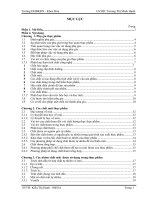product range brief introduction 1 Phụ gia thực phẩm ( food additives)
Bạn đang xem bản rút gọn của tài liệu. Xem và tải ngay bản đầy đủ của tài liệu tại đây (3.87 MB, 80 trang )
CP Kelco Product Overview
GENU® Pectin
GENU® Carrageenan
KELTROL® Xanthan Gum
KELCOGEL® Gellan Gum
CEKOL® Carboxymethyl Cellulose
GENU® Pectin
www.cpkelco.com
What is Pectin?
Origin
Plant / Fruit
Chemical
Carbohydrate
Polysaccharide
Polygalactan
Functionality
Gelling agent
Stabilizer
Thickening agent
The Lemon Tale
1 Lemon
(200 g)
Lemon Peel
(100 g)
Dried Peel
(13 g)
Pectin
(3 g)
Jam
(1000 g)
JA M
Lemon Juice
(100 g)
Lemon Oil
Cattle Feed
(10 g)
Pectin Sources
Florida
Mexico
Orange
Lime
Brazil
Peru
Orange
Lime
Argentina
Lemon
General Pectin Manufacturing
GENU® HM-pectin
GENU® LM-pectin
Citrus
Citrus peel
peel
Water
Water
Acid
Acid
Extraction
Extraction
Filtration
Filtration
Alkali/Acid
Alkali/Acid
Residue
Residue
Evaporation
Evaporation
Alcohol
Alcohol
Deesterification
Deesterification
Isolation
Isolation
Alcohol
Alcohol recovery
recovery
Sugar
Sugar
Drying
Drying
Drying
Drying
Milling
Milling
Milling
Milling
Blending
Blending
Sugar
Sugar
Blending
Blending
Basic Structure of Pectin*
Alpha (1-4) linked D-polygalacturonic acid
~500 repeating units / molecules
Degree of esterification (DE) = amount of acid groups that are esterified
Pectin Functional Groups
COOH
α - D - GALACTURONIC ACID
O
HO
OH
COOCH
α
- D - GALACTURONIC ACID
- METHYL ESTER
O
HO
OH
α - D - GALACTURON
CONH
- AMIDE
O
HO
OH
2
3
Types of Pectin
High Methoxyl Pectin (HM)
Low Methoxyl Pectin
Low Methoxyl Conventional (LMC)
Low Methoxyl Amidated (LMA)
*
Pectin Gel Characteristics
High Methoxyl Pectin *
pH = 3.5 or lower (range: 1.0 to 3.5)
Soluble solids = 55% or higher (range: 55% to 85%)
Calcium is not normally a factor
Low Methoxyl Pectin *
pH = 1.0 to 7.0 or higher (pH affects texture)
Soluble solids = 0% to 85% (soluble solids affects calcium
requirement)
Calcium = REQUIRED
Comparison of Functional
Properties
PROPERTY
HM
LMC
LMA
Response to
mechanism
shear
Gel is broken;
does not re-knit;
syneresis occurs
Generally shear
reversible at all
pH’s
Shear reversible
at pH above 3.5,
not reversible
below 3.5
Setting
temperature of
gel
Can be varied
from 35’C to 90’C
Usually 40’C to
100’C
Usually 30’C to
70’C
Thermal
reversibility of
gel
Generally no
Yes; re-melt
temperature can
be up to 150’C
Yes; re-melt
temperature
usually below 75’C
Comparison of Functional
Properties
PROPERTY
HM
LMC
LMA
Texture of gel
at pH values of
3.5 or lower
Jello-like; rigid gel
(will hold a cut
surface)
Preserve-like;
spreadable; some
degree of gel
structure
Jello-like or HMlike; but more
rubbery (will hold
a cut surface)
Texture of gel
at pH values of
3.5 or higher
Will not gel; will
provide some
viscosity
Preserve-like;
spreadable;
thixotropic (will
not hold a cut
surface)
Preserve-like;
spreadable;
thixotropic (will
not hold a cut
surface)
Main Applications
Traditional high sugar products
Jams and jellies*
Confectionery (Pectin jellies)*
Reduced sugar / calories products
Jams, jellies and conserves
Industrial fruit products
Baked / Heat stable fillings*
Fruit bases (Fruit preparation for yoghurt)
Glazes
Main Applications
Beverages
Non-dairy (Juices and fruit concentrates)*
Acid milk (drinking yoghurt)*
Desserts
Water / fruit based
Milk based (yoghurt)
GENU® Carrageenan
www.cpkelco.com
Product Description
Carrageenan is extracted from red seaweed in water under
neutral or alkaline conditions at elevated temperature
It is isolated from liquid by
Alcohol precipitation
Potassium gelation
Commercial carrageenan is frequently standardized with sugar
and/or contains gelling salts for optimal gelling and thickening
properties
Semi-refined carrageenan is washed and alkali treated
seaweed – carrageenan is contained in the cell matrix
Carrageenan structure
Kappa carrageenan
Iota carrageenan
Lambda carrageenan
Commercial carrageenans:
Mixture
Hybrids
Seaweed Raw Materials
Eucheuma spinosum
Gigartina radula
Eucheuma cottonii
Iota carrageenan
Kappa carrageenan
Chondrus crispus
Kappa/lambda carrageenan
Kappa/lambda carrageenan
Several species of seaweeds are used
for commercial production of
carrageenan
Seaweed Procurement
Species are chosen based on their carrageenan content,
availability and ease of harvesting or potential for farming *
Chondrus *
Spinosum
Cottonii *
Spinosum *
Cottonii
Gigartina *
Manufacturing Process
Seaweed
Seaweed
Cleaning
Cleaning
optional
Alkaline
Alkaline treatment
treatment ** &
& cleaning
cleaning of
of seaweed
seaweed
Hot
Hot extraction
extraction of
of carrageenan
carrageenan
from
from seaweeds
seaweeds
Purification
Purification of
of solution
solution
optional
optional
Concentration
Concentration of
of solution
solution
Carrageenan
Carrageenan precipitated
precipitated by
by
alcohol
alcohol
Carrageenan
Carrageenan gelation
gelation by
by
salt
salt
Mechanical
Mechanical dewatering
dewatering
Drying
Drying &
& grinding
grinding
Drying
Drying &
& grinding
grinding
Refined
Refined carrageenan
carrageenan
Semi-refined
Semi-refined carrageenan
carrageenan
Performance
Performance adjustment
adjustment by
by
adding
adding sugar/salts
sugar/salts
Performance
Performance adjustment
adjustment by
by
adding
adding sugar/salts
sugar/salts
Ideal kappa-Carrageenan Structure
OSO 3 -
K, Ca, Na
3-linked β-D-galactose-4sulphate
CH 2OH
CH 2
O
O
O
O
O
OH
4-linked 3,6-anhydro-α-D- OH
galactose
n
*
Ideal iota-Carrageenan Structure
-
OSO 3
Ca, K, Na
3-linked β-D-galactose-4sulphate
CH2 OH
CH 2
O
O
O
O
OH
O
4-linked 3,6-anhydro-α-D- OSO 3
galactose-2-sulphate
n
*
Ideal Lambda-Carrageenan Structure
OH
3-linked β-D-galactose-2sulphate
CH OH
K, Ca, Na
O
2
O
OSO
-
O
3
CH
OSO
2
O
3
HO
4-linked α-D-galactose-2,6disulphate
OSO 3-
n
*
Basic properties - texture
Kappa-like:
Firm - Brittle - Syneresis
Iota-like:
Elastic - Soft - No syneresis
Lambda-like:
No gelling - Thickening - Provides “body”
Basic Properties - Solubility
Medium
Kappa
Iota
Lambda
Hot water
Soluble > 60°C
Soluble > 60 °C
Soluble
Cold water
Na+ salt soluble; K+ & Ca++
salt insoluble
Na+ salt soluble;
swells
Hot milk
Soluble
Soluble
Soluble
Cold milk
Insoluble but swells
markedly
Insoluble
Soluble
Concentrated sugar
solutions
Soluble hot
Slightly soluble hot (not
easily soluble)
Soluble hot
Concentrated salt
solutions
Insoluble
Soluble hot
Soluble hot
35% alcohol
solutions
Insoluble
Insoluble
Na+ salt soluble
Viscosity
Low
Medium
High
Ca++ salts
Soluble









